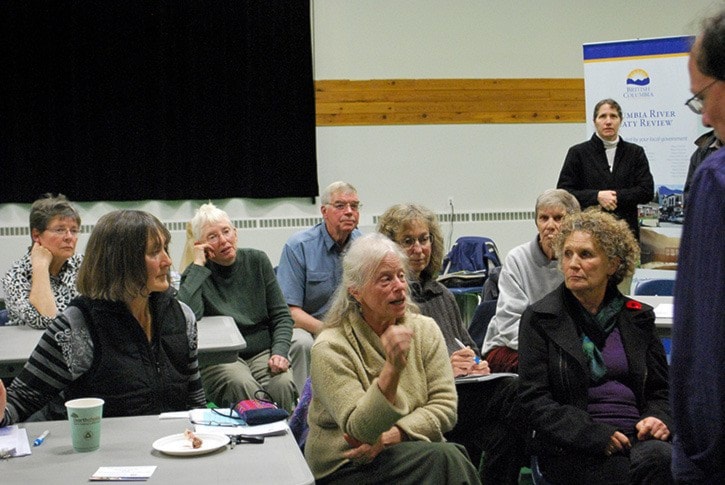The afternoon and evening Nakusp sessions of the Columbia River Treaty workshop on Nov. 6 were packed with over 50 people each, as representatives Kelvin Ketchum (BC Hydro), Kathy Eichenberger (Provincial rep, CRT review team), and Karen Hamling (Local Governments Committee) laid out what information has been collected through the public consultation process.
Eichenberger told the crowd that the majority of basin residents were in support of treaty continuation, and being part of the process. Residents didn’t want to see any more social or environmental impacts or flood risk, and wanted better trans-boundary planning, but they do want to see that compensation for flood control reflected the value of the service, and that all kinds of water usage were valued appropriately. Addressing the inequity of affected communities and those that have benefited remains a prime concern. Climate change, stable reservoir levels, the return of salmon to the Columbia, and a water usage plan for the Kootenay/Koocanusa system were also high priorities.
Keeping reservoir levels as constant as possible, a requirement for a thriving riparian zone, was one issue discussed in Nakusp. Kelvin Ketchum outlined two alternatives: if the treaty is terminated, Arrow operations could shoot for stabilization around 1,425 or 1,420 ft, but there would be no flood control for U.S. which would mean a stable water level but no revenue from flood control. With stabilization would come a larger wildlife area and an improvement of shore-based recreation. On the flip side, the amount of time that nutrients would be available to organisms that feed on them would decrease, the capacity for boating would be lower with a smaller reservoir, and transportation of log booms could be interfered with at 1,420 ft.
One member of the afternoon audience pointed out that Kokanee access to spawning beds is better at lower flow levels, and she inquired if levels could be kept close to 1,420 ft with a treaty continue option. Eichenberger said that it could be considered, that the models that were being presented just scratched the surface and that input would help in making decisions.
“Often people don’t give suggestions,” she said, “but Burton and Fauquier did.”
Eichenberger noted that there is a lot of passion on both sides of the border around restoring salmon migration in the Columbia, and salmon are one issue about which there is unanimous agreement. Technically, each nation is responsible for their own structures, and according to Eichenberger, BC Hydro has said that if there are steps taken to enable salmon to migrate across the Grand Coulee Dam and all the way into Canadian waters, they would look at how to open up fish passage into the upper Columbia. Currently, the Grand Coulee Dam, built between 1933 and 1942, blocks salmon passage to Canada. Getting fish past Revelstoke and Mica will be a challenge, she said, but there are already provisions for the three other dams on the Canadian side.
It was also pointed out that money from power generation is reduced in treaty termination scenarios, as the Canadian Entitlement no longer exists. The estimated amount of the average annual Entitlement amount over the past ten years was given as roughly $200 million, an amount that was portrayed would be missing if the treaty were terminated. One attendee said that wasn’t a fair characterization because it was clear the U.S. would be coming to the table with the intention to severely reduce the Canadian Entitlement, so any theoretical loss was unknown.
RDCK Director Andy Shadrack pointed out the need for basin-wide discussion about the effects of climate change, giving the Columbia wetlands that are fed by diminishing glaciers as an example of one area of many that need to be taken into consideration.
Another Nakusp resident raised the issue that pieces of the conversation around the treaty, such as first nations discussions, are unknown.
“How do we know they’ll listen to us?” she said, concerned that issues raised in these sessions would be overlooked at the negotiating table. First nations are now taking part in the Local Government Committee Eichenberger responded, and that committee will be on hand at any negotiations, although they will not be at the table themselves.
The value of water was raised more than once, with residents pointing out that the U.S. uses water for more than just power generation, but also for irrigation as well as recreation and maintaining their ecosystems. Eichenberger agreed that the value of non-power benefits has been overlooked, and how water value is calculated needs to take into account far more than it has to date.
“This is not the enemy,” said Nakusp mayor Karen Hamling before the Local Government session, pointing to Kathy Eichenberg after the question and answer period. The mayor, who attended a couple of stateside meetings, said our neighbours to the south are unaware of the history and the contemporary issues up here, and are just beginning to find out. She stressed that, other than the air we breathe, water is the most precious commodity we will ever have, and encouraged people to contribute their comments about the draft recommendation.
